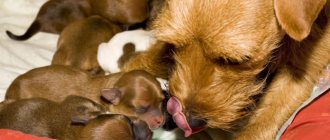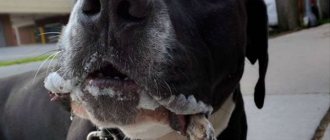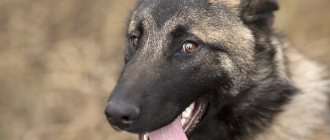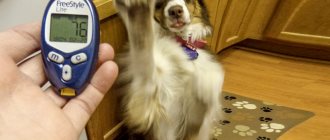If your dog is about to become a parent in the near future, then, of course, this is very exciting. You may fear for your pet's health and worry about the birth process. This is all normal.
In order not to get into trouble and to be fully prepared, it is better to thoroughly prepare for this process. Extra knowledge on the issue of giving birth to a dog will not hurt.
How to determine the approach in a week
Already a week before giving birth, the dog prepares physically. Here are the signs by which you can determine that in 5-7 days she will bring you puppies:
- At this time, the expectant mother begins to worry , look for a cozy corner, and fawn over the owner.
- During this period, it is necessary to pet your pet more often, to show with all your appearance that he has protection in your face.
- Some animals have a decrease in appetite , at this time you can pamper your pet with some kind of treat. Give more dairy products and broths.
Already from 57-58 days it is necessary to measure the dog’s body temperature twice a day. If the temperature data has decreased by 1-1.5 ºС, then this is a harbinger of an early birth. Within 24 hours the babies should be born. Immediately before birth, body temperature returns to normal.
Important! But if a low temperature or, on the contrary, an elevated one to 39 ºС lasts more than a day, then this is a reason to seek medical help. Perhaps the death of the fetus occurred and intoxication of the body began.
Preparing for childbirth
Preparations for the birth of a dog should be done in advance. Knowing the exact date of mating, it is easy to determine the date of birth of the dog. As a rule, pregnancy lasts 58-66 days. Often a small dog gives birth a little earlier, while larger breeds give birth a little later. Premature births in dogs are rare; this may be due to pathology. When labor begins early, consultation with a specialist, and sometimes his help, is required.
A week before the dog is expected to give birth or prenatal signs appear, the area needs to be prepared. It’s good if there is a suitable separate room for this. If not, then you need to choose a corner where it will be warm, there will be no drafts and bright light. The optimal temperature suitable for a whelping bitch is from 20°C to 25°C.
It is important that this place is not on the aisle, and that household members do not disturb the dog during this period. In addition, the maternity place should have easy access to those who will monitor the process and provide assistance if necessary.
What is needed for childbirth, besides a prepared place:
- a box where born puppies can remain while the next ones are born;
- a lot of unnecessary clean cloth made from natural fibers, which can be laid under the dog, in a box for puppies, or to wipe them off if the bitch does not have time to lick everyone;
- clean water for wiping the woman in labor, puppies, and for washing hands;
- sterile bandages or gauze wipes;
- white cotton threads disinfected in alcohol for ligating the umbilical cord;
- clean scissors with rounded edges;
- medical tweezers with a lock;
- a means for disinfecting the belly buttons of puppies (brilliant green, potassium permanganate solution, or special disinfecting sprays).
The dog drinks a lot of water before and during birth, so a bowl of water should always be nearby. You can’t pour a lot of water into it at once; you need to drink it little by little, but often.
How can you tell if a bitch is giving birth today?
How does your pet behave before starting?
Experts distinguish three stages of the onset of labor:
- The first stage is preparatory, when the opening of the birth canal begins.
- The second stage is characterized by contractions.
- The third stage is the birth of puppies and the release of the placenta.
It is during the period of preparation for childbirth that the dog’s behavior changes not only physiologically, but also psychologically. It is expressed as follows:
- There is obvious restlessness in behavior, the bitch rushes around the house, begins to dig the floor or her bedding, and sometimes hides in a secluded place.
- It’s hard for her to stay in one place, she either lies down, gets up, or spins around.
- Some breeds become too affectionate during this period; they do not leave their owner’s side and look into his eyes in a special way.
- Some dogs start asking to go outside, take them out, but soon bring them back home .
- Some bitches lose their appetite, others ask for food, and others start vomiting. In this case, everything is individual.
Important! Changes in the animal's behavior require active participation on the part of the owner. He should show more attention and affection than usual. All these signs occur due to an increase in intra-abdominal pressure before childbirth. The first contractions of the uterus do not yet bring pain to the dog, but cause anxiety.
Physiological changes – temperature, water, etc.
Physiological changes as labor approaches include :
- Within 3-4 days, the bitch’s belly begins to “sag”.
- When looking at your pet from above, it seems that he has lost weight and you can even see “hungry” cavities on the sides.
- Although firstborns may not have these signs.
- Decrease in body temperature in dogs by 1-1.5 ºС 8-24 hours before birth. So, if a bitch’s temperature norm is 38-39 ºС, then before giving birth it drops to 37-37.5 ºС.
- And another sign of imminent delivery is a sharp subsidence of the puppies in the womb, which were previously actively pushing and moving.
A few hours before the birth of the cubs, the plug begins to come off, that is, a liquid whitish discharge appears .- During this period, the dog begins to tremble and chills, and the heartbeat and breathing increase.
All these physiological changes indicate that soon, in about a day, the puppies will be born .
The preparation stage can last from several hours to one day. If this time continues for more than 24 hours, and the dog does not go into labor, contact your veterinarian immediately.
How to help a dog during childbirth
Sometimes a dog may not perform its duties when giving birth to puppies. The reasons may be different - the bitch is inexperienced, the puppies are born very quickly and she does not have time, reluctance. In this case, in order to save the puppies, you will have to participate in the process.
How to give birth to a dog and assist it:
- During pushing, you can help the puppies move forward. To do this, you need to lightly press on the upper abdomen and, as it were, move the puppy towards the exit. This should be done only in time with attempts;
- After birth, carefully tear apart the shell in which the puppy is located. They tear it near the muzzle so that he can quickly breathe;
- the nose and mouth are freed from the mucus located there;
- The puppy is wiped with a clean cloth, gently massaging its body;
- the puppy's squeak indicates that the lungs are working;
- Only after this, not before, should the umbilical cord be cut off or cut off.
It is better to cut off the umbilical cord - this will prevent bleeding, the entry of microbes and will speed up the healing of the wound. If there is no experience in this, then it is cut off. The blood from the umbilical cord is driven towards the puppy’s tummy, and at a distance of 2-3 cm from the body the umbilical cord is clamped with tweezers with a clamp. The umbilical cord is cut with sterile scissors. It is tied with alcohol-soaked thread near the incision site. The clamp is removed and the umbilical cord is generously lubricated with disinfectant.
After this, the puppy is applied to the nipple. I put the nipple in his mouth, lightly press the base so that the milk splashes out. Having felt the taste of milk, the puppy begins to suck on its own. Before the second puppy is born, it is placed in a separate box and returned to its mother after the birth is over.
Features of small breeds
Small breeds, such as dachshunds, Yorkshire terriers, chihuahuas and toy terriers, give birth in the same way as large breeds. But the period before childbirth may have distinctive features . The nervous system of small breeds is too delicate, so prenatal behavior will be more pronounced in them than in large dogs.
Yorkies, toy terriers, chihuahuas, and standard dachshunds bear their offspring for an average of 60-63 days; dwarf and rabbit dachshunds are pregnant for no more than 60 days.
Reference. The smaller the bitch, the fewer days she is pregnant.
Primipara
Help
Many people are concerned about whether it is necessary to call a veterinarian for help if the dog is primiparous. Experts recommend doing this if the owner himself has never encountered the birth of a dog and does not know how to behave in this case. If the owner has encountered such a situation before and even participated in this process himself, then there is no need to worry. Although it is advisable to take the doctor’s number first.
Behavior
All the prenatal signs of a first-born dog will be much brighter than those animals that have already experienced giving birth to puppies. They rush around the house, can tear up the bedding, begin to whine loudly and even make sounds similar to a groan. 1-2 days before the start of the birth process, the animal may refuse food , but many dogs, on the contrary, are not averse to eating well. In general, the behavior of the firstborn is the same as that of all other pregnant dogs.
Primiparous dogs may not have as obvious external signs that she is about to give birth. If usually before the birth of puppies in animals, the belly drops and “hungry” pits form, then in firstborns these signs may not be noticeable.
Stages of labor in a dog
The process of birth of newborn puppies is determined by a number of hormonal and mechanical factors. Veterinarians-obstetricians distinguish the following stages of labor in dogs:
- Preparatory stage . Under the influence of the hormone cortisol, synthesized by fruits, prostaglandins are activated. This leads to increased excitability of uterine receptors. There is an increase in the tone of the muscles of the reproductive organ, preparing the birth canal for the advancement of the fruit. At this stage, the owner observes contractions in the dog. The onset of labor can be felt especially well if you place your hand on your pet’s belly.
- The period of cervical dilatation . The stage is accompanied by full opening of the birth canal and pushing. The discharge of amniotic fluid is noted. The animal strains, as if in the act of bowel movement.
- Stage of expulsion of fruits . At this time, the striated muscles of the uterus contract. Increased pressure in the abdominal cavity contributes to the mechanical movement of the fetus outward. At the same time, cephalic and pelvic presentation of the puppy is considered normal in obstetric practice.
- Postpartum stage. Contractions of the uterus lead to the expulsion of the remaining placenta. The placenta is separated after the birth of each puppy. It often happens that several newborns can be in one amniotic sac, but each of them has its own place for children. The dog can eat the afterbirth. This will not cause harm, but many owners remove the nursery area themselves, without giving it to the female.
After birth, the mother chews the amniotic sac, gnaws the umbilical cord, licks the babies, freeing the airways and stimulating independent breathing.
Quick (quick) birth
Rapid or rapid labor in dogs is characterized by the birth of puppies - in 2-4 hours in multiparous females and in 4-6 hours in primiparous females. The danger of such births is that the waters break quickly, and the puppy has not yet been born . In this case, he may catch some kind of infection.
In addition, during rapid labor, the dog’s uterus contracts faster, and this condition can damage the fragile body of newborns, for example, injuring the cervical spine of puppies . Therefore, with a quick birth, you need to seek help from a professional.
Start of labor
Before labor begins, the dog calms down a little and almost never leaves the prepared area. She begins to have contractions, then they are accompanied by attempts that are visually noticeable. When pushing, the abdomen and diaphragm contract; it seems as if there is a “wave” going from the upper abdomen to the lower.
How to understand that a dog is already giving birth:
- as soon as contractions begin, the dog lies on its side;
- contractions become more frequent;
- amniotic fluid drains;
- attempts become noticeable.
If about two hours have passed since the release of amniotic fluid, and the interval between contractions is 2-3 minutes, then the first puppy is on the way.
Usually the bitch herself chews the shell in which the puppy is located, licks it and gnaws the umbilical cord. There is no need to interfere with this. 20 minutes after birth, the afterbirth comes out, which the bitch eats. It is not recommended to allow her to eat more than two or three pieces, otherwise it may cause stomach and intestinal upset. The placenta may come out later - before the birth of the next puppy or at the same time as it. The number of afterbirths must correspond to the number of puppies. If one does not come out 3 hours after the end of labor, you should sound the alarm.
The puppy is left near its mother for a while so that it begins to suckle milk. This provokes new contractions and speeds up the birth of the next puppy. Then it must be put in a separate box so that the bitch does not crush it during the birth process.
How long childbirth lasts in dogs, how long the bitch rests between giving birth to puppies - everything is very individual. This depends on various factors - the number of puppies, the health of the bitch, hereditary factors, the first or second whelping. Practice shows that in dogs of small and large breeds, childbirth is longer and more difficult than that of medium breeds, although there are exceptions.
Having knowledge of how a dog gives birth correctly, you can understand whether everything is going as it should. Problems during childbirth when specialist help may be required:
- if two hours have passed since the water broke and the puppy does not appear;
- if the interval between the birth of two puppies lasts more than 6 hours;
- the birth ended 3 hours ago, all the puppies were born, and the number of afterbirths that came out was less than the number of puppies.
Carrying out the process at home
If you are new to this matter, it is better to enlist the help of a veterinarian or take your pet to the clinic. But it happens that there is no choice but to give birth to a dog yourself . Start preparing for this process in advance.
Remember that giving birth to puppies is a messy business, so have as many rags ready as possible . The blanket that you will lay under the bough will subsequently have to be thrown away, so there is no need to take a new one.
After this, a place for the birth is selected, as well as a box for the puppies . If the dog is large, then you can prepare a playpen; if it is not available, fence off more space and build something like a fence, since small children will actively try to get out from behind the fences. Make sure there is good heating . After this, prepare all the necessary tools for childbirth.
Attention! The day before the bitch whelps, wash the area of your pet's abdomen and genitals, and remove the hair in this area. Long wool is collected with an elastic band.
You should have the following medications on hand:
- Alcohol or vodka.
- Glucose ampoules 5%.
- Syntomycin emulsion 10%.
- Hydrogen peroxide.
- Traumeel and brilliant green.
Don’t forget to also prepare syringes, scissors, silk threads in case of tying the umbilical cord, and be sure to put notes in a visible place with all the phone numbers of veterinarians who will come to your aid at any time of the day.
If the dog itself cannot bite off the umbilical cord, for example, due to the anatomical features of the body, then the owner will have to do this. It is not recommended to use scissors for these purposes, as blood will flow. It's better to pull it and tear it off.
After the birth process begins and the babies come out, be sure to palpate the dog’s belly for any remaining babies. Also, all placenta should come out; if you doubt that the last placenta has come out, you need to contact a veterinarian.
By the way, the dog eats all the afterbirth . But if there are more than 2-3 of them, then do not allow her to eat the rest, otherwise digestive problems will begin. Don't forget to change soiled diapers.
Important! A dog that is exhausted after giving birth should not be disturbed or pulled; provide it with warmth and peace. In the first weeks, you do not need to often approach the mother with the puppies. Excessive attention will disturb the animal.











